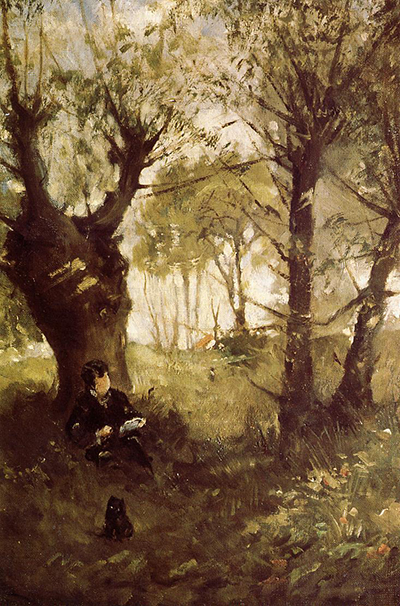The Old Track to Auvers was produced by French Impressionist, Berthe Morisot, in 1863. The artist would have been in her early twenties at that time that she completed this piece.
She would have still been evolving as an artist at this point, searching for her favourite style or content. This piece is therefore slightly unusual when compared to her most famous paintings such as The Cradle, Woman at her Toilette and Eugène Manet on the Isle of Wight. There are no figurative portraits within The Old Track to Auvers, but instead we see a view through a local forest or park, with thick-trunked trees in the foreground. They leave an opening that leads through to a lighter section behind, giving a subtle sense of perspective and also a good contrast in the use of light. Nearest us, for example, the trees leave dark shadows which mainly cover an individual who is sitting quietly, almost unnoticed. Normally her portraits would place the model as the main focal point, with the trees and shrubs serving merely a supporting role. Perhaps this painting is an example of classic Impressionist art, where she was following the approach but had not yet grown the confidence to append her own unique ideas, but those would follow soon.
We see an artist with a strong base of technical ability, and an understanding of how to compose an artwork. The use of light is particularly impressive for someone just starting out as a professional painter, even more so when we remember that much of her early learnings were devoted to drawing. One can imagine this piece being exhibited within an Impressionist exhibition, because of its content, but actually it was her later uniqueness that proved successful, and her male counterparts encouraged the alternative topics that she was focusing on. Eventually she found her way and remained devoted to covering women in society for the rest of her career, though still sometimes dropping into other genres every now and again. Some might even compare this piece to the early Mondrian paintings, before he himself went down a very different path, both in terms of style but also the content that he featured.
This artwork is believed to reside within a private collection and that may be the case for most of Morisot's earliest paintings. It is also relatively small, at 45cm in height and 31cm in width, when normally she would use slightly larger canvases. Ambition and boldness was something that came over time with confidence and at this time Morisot was unsure as to what style would work best, or what she most liked to do. Figurative portraiture always requires considerable practice, where as perhaps she found this type of content easier to master at the start of her career. The Old Track to Auvers offers an important element of variety within her oeuvre and also reminds us of the evolution that she went through during the earliest phases of her career.




